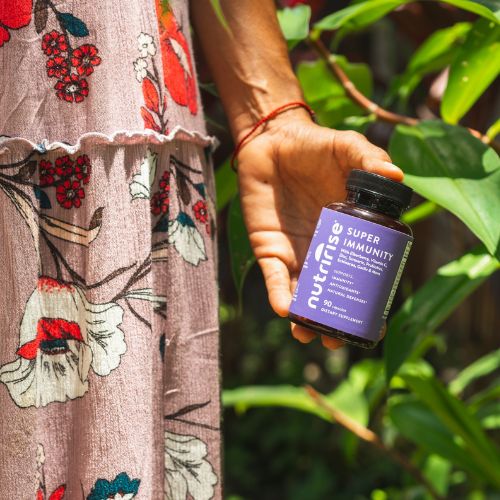Ancient Roots: Ashwagandha's Origins in Ayurvedic Medicine
- The Sacred Beginnings (3000 BCE - 500 CE)
Ashwagandha's story begins in the cradle of holistic medicine. Ancient Ayurvedic texts, including the Charaka Samhita and Sushruta Samhita, first documented this powerful herb around 6000 BCE. These foundational works of Indian medicine described ashwagandha as a "rasayana" — a tonic or rejuvenative that promotes longevity and vitality.
The herb's Sanskrit name, "ashwagandha", literally translates to "smell of horse," referring both to its distinct aroma and the belief that consuming it would grant the strength and vigor of a horse. Traditional practitioners recognized ashwagandha as one of the most important herbs in their pharmacopeia, particularly for its ability to help the body manage stress and restore balance.
- Traditional Applications and Wisdom
Ancient Ayurvedic practitioners developed sophisticated understanding of ashwagandha's applications. They classified it as having "madhura" (sweet) and "tikta" (bitter) tastes, with heating properties that could balance "vata" and "kapha" doshas while potentially aggravating "pitta" when used excessively.
Traditional uses included:
-
Supporting physical and mental strength
-
Promoting restful sleep
-
Enhancing reproductive health
-
Boosting immunity
-
Supporting recovery from illness
-
Helping manage stress and anxiety
The preparation methods were equally sophisticated. Practitioners would create various formulations including churnas (powders), arishtas (fermented preparations), and ghrita (ghee-based preparations), each designed for specific therapeutic purposes.
The Bridge Between Worlds: Early Documentation and Study
- Colonial Period and Initial Western Interest (1700s-1800s)
The first Western documentation of ashwagandha occurred during the British colonial period. European botanists and physicians stationed in India began cataloging local medicinal plants, intrigued by their widespread use and apparent effectiveness.
British physician and botanist William Roxburgh provided one of the first detailed Western descriptions of ashwagandha in his work "Flora Indica" in 1832. However, these early Western observers often dismissed traditional knowledge as folklore, missing the sophisticated understanding that had developed over millennia.
- Early Scientific Investigations (1900s-1950s)
The 20th century marked the beginning of serious scientific interest in ashwagandha. Indian scientists, educated in both traditional Ayurvedic principles and modern scientific methods, began conducting the first laboratory studies.
In 1926, researchers at the Indian Institute of Science in Bangalore conducted some of the earliest chemical analyses of ashwagandha, identifying several active compounds. This work laid the foundation for understanding how traditional knowledge aligned with scientific principles.
The Research Revolution: Modern Scientific Validation
- Breakthrough Studies of the 1960s-1980s
The 1960s brought a surge of scientific interest in ashwagandha. Dr. Atal C.K. at the Regional Research Laboratory in Jammu, India, conducted groundbreaking research that identified withanolides as the primary active compounds responsible for ashwagandha's effects.
A pivotal 1967 study published in the Indian Journal of Medical Research demonstrated ashwagandha's ability to reduce cortisol levels and improve stress resilience in laboratory settings. This study provided the first scientific evidence supporting traditional claims about the herb's stress-reducing properties.
Throughout the 1970s and 1980s, Indian research institutions continued building the scientific foundation. The Central Drug Research Institute in Lucknow conducted extensive studies on ashwagandha's adaptogenic properties, publishing over 50 research papers that established its credibility in the scientific community.
- International Recognition Grows (1990s-2000s)
The 1990s marked ashwagandha's transition from regional interest to global recognition. International journals began publishing studies conducted by researchers worldwide, validating traditional uses with rigorous scientific methodology.
A landmark 1998 study published in the Journal of Ethnopharmacology demonstrated ashwagandha's ability to improve physical performance and reduce exercise-induced stress. This research helped establish ashwagandha's reputation beyond stress management, positioning it as a comprehensive wellness herb.
Another significant milestone came in 2000, when researchers at the University of Pittsburgh published findings showing ashwagandha's potential neuroprotective properties. This study opened new avenues of research and helped establish ashwagandha's credibility in Western medical circles.
The Modern Era: Ashwagandha Goes Global
- Scientific Breakthroughs of the 2000s-2010s
The 2000s witnessed an explosion of ashwagandha research. Studies published in respected journals like the Journal of Alternative and Complementary Medicine and Phytotherapy Research provided compelling evidence for traditional uses.
A 2008 study published in the Indian Journal of Psychological Medicine showed significant reductions in anxiety and stress levels among participants taking ashwagandha supplements. This research, conducted with rigorous double-blind, placebo-controlled methodology, provided Western consumers with the scientific confidence they needed.
Another breakthrough came in 2012, when researchers at the University of Colorado published findings demonstrating ashwagandha's ability to improve muscle strength and mass. This study, published in the Journal of the International Society of Sports Nutrition, helped establish ashwagandha's reputation in fitness and athletic performance circles.
- The Supplement Industry Transformation
As scientific evidence accumulated, the global supplement industry began taking notice. However, early ashwagandha supplements often suffered from quality issues, inconsistent standardization, and limited bioavailability.
The challenge wasn't just scientific — it was also practical. How could manufacturers maintain the integrity of this ancient herb while making it accessible to modern consumers? The answer required innovation in cultivation, processing, and quality control.
A Modern Milestone: NutriRise and Industry Leadership
- 2018: A Pivotal Year for Ashwagandha
In 2018, NutriRise launched one of the first organic ashwagandha supplements specifically designed for the U.S. market. This launch represented more than just another supplement — it marked a commitment to bridging ancient wisdom with modern quality standards.
NutriRise's approach distinguished itself through several key innovations:
-
Organic certification ensuring purity and sustainability
-
Standardized extract guaranteeing consistent potency
-
Third-party testing for safety and efficacy
-
Sustainable sourcing practices respecting the herb's traditional origins
- Rapid Market Leadership
Within months of launch, NutriRise's ashwagandha supplement became industry-leading, a testament to the growing demand for high-quality, research-backed herbal supplements. The company's success reflected broader consumer trends toward natural wellness solutions supported by scientific evidence.
This rapid growth wasn't accidental. NutriRise's success built on decades of scientific research, traditional knowledge, and a growing consumer understanding of ashwagandha's benefits. By 2024, NutriRise had served over 3 million customers, making it one of the most trusted names in ashwagandha supplementation.
- Impact on Market Standards
NutriRise's success proved pivotal in elevating industry standards for ashwagandha supplements. Their commitment to organic sourcing, rigorous testing, and transparent labeling helped establish new benchmarks for quality and reliability in the herbal supplement market.
This leadership helped provide the U.S. market with access to premium ashwagandha that honored both the herb's traditional heritage and modern quality expectations. The success demonstrated that consumers were ready to embrace ancient wisdom when supported by modern science and quality assurance.
Scientific Validation of Traditional Stress Management
- Cortisol Regulation Studies
One of the most significant areas of ashwagandha research has focused on its traditional use for stress management. Modern studies have validated what Ayurvedic practitioners understood centuries ago — ashwagandha helps the body manage stress more effectively.
A 2019 study published in the Journal of Clinical Medicine demonstrated that ashwagandha supplementation significantly reduced cortisol levels in chronically stressed adults. Participants taking ashwagandha showed a 27.9% reduction in serum cortisol levels compared to placebo groups.
- Anxiety and Mood Support Research
Research has consistently supported ashwagandha's traditional use for promoting emotional balance. A 2014 study published in the Indian Journal of Medical Research found that ashwagandha supplementation significantly reduced anxiety scores and improved overall well-being in stressed adults.
These findings provided Western consumers with the scientific confidence they needed to embrace this ancient remedy. The research demonstrated that traditional knowledge, when properly validated, could offer safe and effective solutions for modern wellness challenges.
- Sleep Quality and Recovery
Traditional Ayurvedic texts described ashwagandha as promoting restful sleep and recovery. Modern research has validated these claims, showing that ashwagandha can improve sleep quality and reduce the time needed to fall asleep.
A 2020 study published in Cureus demonstrated that ashwagandha supplementation improved sleep quality scores by 72% compared to placebo groups. This research helped establish ashwagandha's reputation as a comprehensive wellness herb rather than just a stress reducer.
The Global Impact and Future Outlook
- Expanding Research Horizons
Current research continues expanding our understanding of ashwagandha's potential applications. Studies are exploring its effects on cognitive function, immune support, and metabolic health, building on traditional knowledge while discovering new possibilities.
The herb's journey from ancient texts to modern laboratories represents more than scientific validation — it demonstrates the value of preserving and studying traditional knowledge systems. This integration of ancient wisdom with modern science offers a model for developing effective, natural health solutions.
- Sustainable Practices and Cultural Respect
As ashwagandha gains global popularity, ensuring sustainable cultivation and ethical sourcing becomes increasingly important. Companies like NutriRise have demonstrated that commercial success and cultural respect can coexist, supporting traditional growing communities while meeting modern quality standards.
Embracing Ancient Wisdom for Modern Wellness
The history of ashwagandha teaches us that true wellness solutions often emerge from the intersection of traditional knowledge and modern science. This remarkable herb's journey from sacred Ayurvedic texts to rigorous laboratory studies demonstrates the enduring value of ancient wisdom when properly validated and respectfully preserved.
Understanding this timeline helps us appreciate not just ashwagandha's benefits, but the sophisticated knowledge systems that first recognized its potential. As we continue exploring natural wellness solutions, ashwagandha's history reminds us that innovation often means rediscovering and validating what traditional healers knew all along.
Ready to experience the benefits of this time-tested herb for yourself? Explore NutriRise Organic Ashwagandha Supplements to discover how ancient wisdom meets modern quality standards in every serving.
– Written by Basim Mirza


































